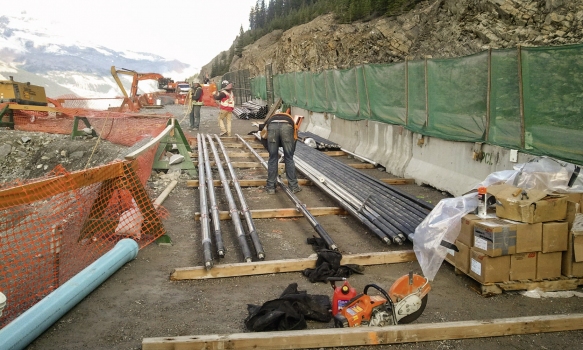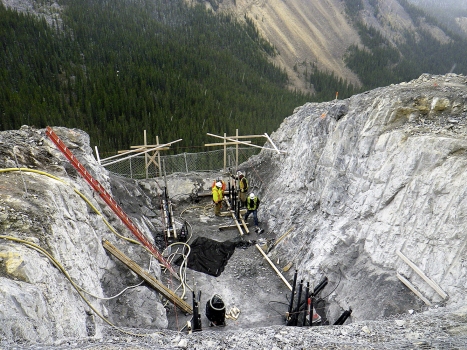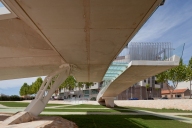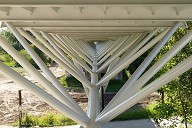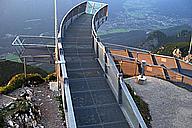Glacier Skywalk in Canada’s Jasper National Park
Since May 2014, Jasper National Park in Alberta, Canada, features a spectacular highlight for visitors: the Glacier Skywalk. The skywalk is a visitor platform with a glass floor on a steel frame structure that extends from a cliff at a height of 280 m. The cantilevered platform was erected at an existing road and extends over 30 m from the rock. It provides tourists with an impressive view of the Sunwapta Valley with its glacier fields and steep rock walls.
Media
The viewing platform contains a draped cable in its inside radius. A large compression chord acts together with steel framing members to provide torsional resistance under partial load. Tuned mass dampers in the walkway minimize vibrations caused by walking, and wind deflectors attached to the outer handrails reduce swinging caused by crosswinds.
600 t box girders secure the skywalk
The 30 m long glass skywalk is supported by 600 t of cantilevered, trapezoidal box girders secured onto tied back foundation blocks. The foundations were anchored in depths of 10 to 20 m in the load-bearing rock using rock anchors. DSI Canada supplied 48 rock anchors for tying back the foundation blocks. Sixty-four micropiles and double corrosion protected rock anchors were installed in the concrete foundations for the box girders. The concrete foundations were further post-tensioned with 77 tendons. The steel frame structure was secured to the concrete foundations using 80 post-tensioned anchor bolts. Two Type 9-0.6" strand tendons in steel ducts were used to support the cantilevered glass platform.
DSI Canada provided technical assistance for all of the products that were supplied and also provided the equipment needed for tensioning the anchors. An experienced DSI technician supervised the construction work on site.
Difficult construction in sub-alpine terrain
Due to the remote sub-alpine terrain, construction work was very difficult. The constrained site access prevented using cranes for the stressing. Scaffold sections had to be set up and manual chain falls had to be used to hoist equipment. This meant all materials and equipment had to be prepared ahead of moving the suspended structure into place – the large lifting crane would have blocked any subsequent access to the jobsite.
Prize for Future Projects Category
Site conditions required quick design changes. In some cases, DSI had to produce and supply additional products just in time in order to make use of the short time frame in which the construction work could be carried out due to the extreme local weather conditions. Even before construction of the skywalk started in 2011, the project won the Future Projects Category at the World Architecture Festival in Barcelona.
References
Structure Types
- About this
data sheet - Product-ID
7422 - Published on:
11/09/2016 - Last updated on:
02/04/2022


